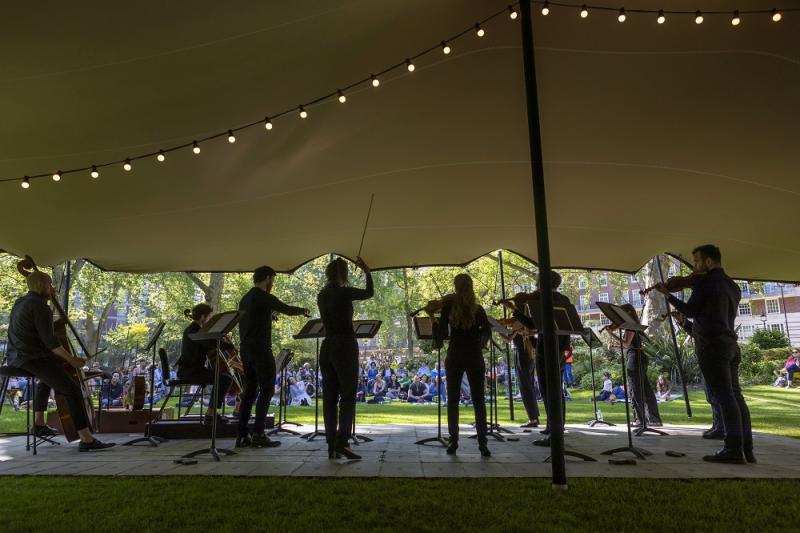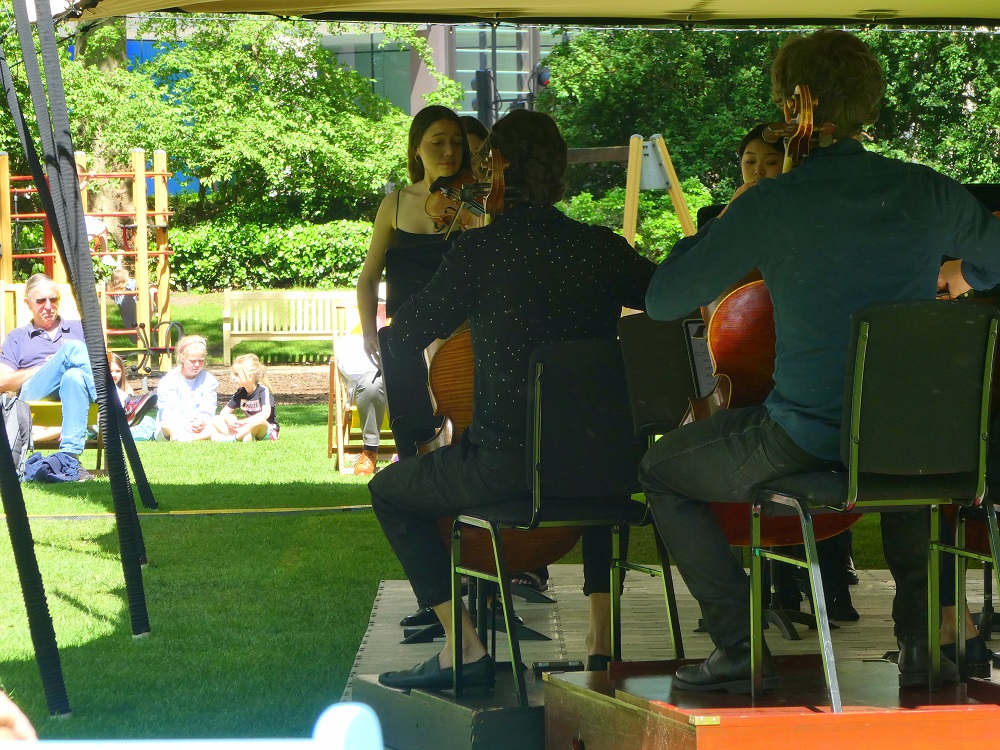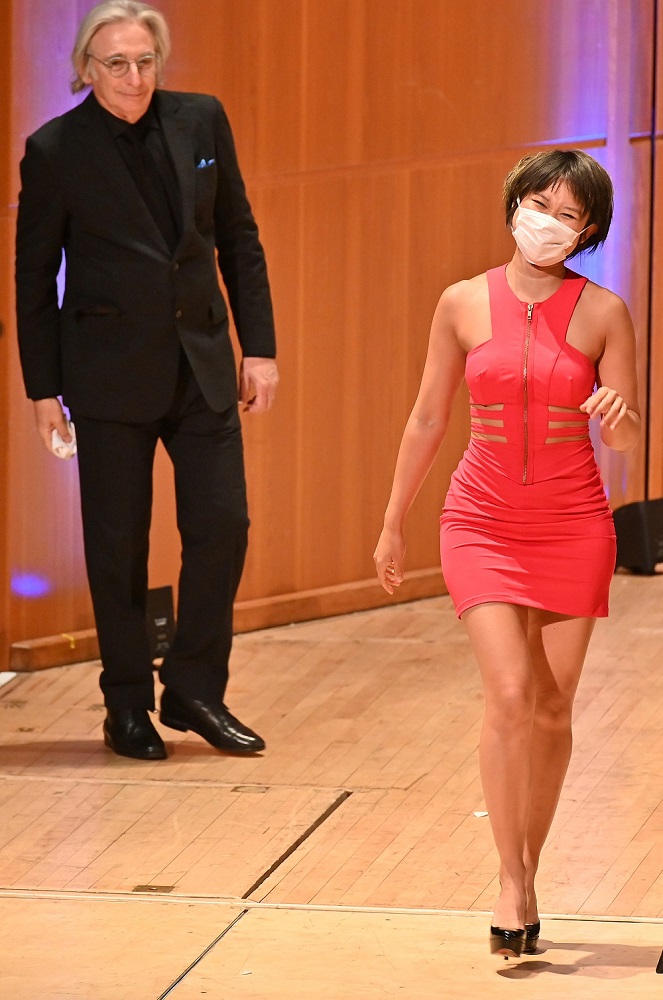Wigmore Hall at Portman Square / Wang, LSO, Tilson Thomas, LSO St Luke's review - al fresco chamber, full orchestra indoors | reviews, news & interviews
Wigmore Hall at Portman Square / Wang, LSO, Tilson Thomas, LSO St Luke's review - al fresco chamber, full orchestra indoors
Wigmore Hall at Portman Square / Wang, LSO, Tilson Thomas, LSO St Luke's review - al fresco chamber, full orchestra indoors
An exhilarating Sunday moving from percussionists to strings and on to a big symphony

Sometimes the big musical institutions follow off-piste trailblazers.
These weren't the only Wigmore events: the hall was celebrating its 140th anniversary (yesterday was the actual day), so you could in fact take your pick of five concerts, the open-air ones absolutely free (if you'd booked quick enough): half an hour after the Beaten Track Ensemble kicked off their family-friendly entertainment in the square, the Doric Quartet and Tim Posner were playing Schubert’s String Quintet in the temple of art down the road, and after the two identical programmes from the 12 Ensemble outside, you could take a break and catch the second of András Schiff’s recitals (Jessica Duchen reviewed the first here in ecstatic terms). My own pleasant surfeit was to cycle to LSO St Luke’s via an hour in Regent’s Park to hear the first full romantic symphony live in over a year (Tchaikovsky 2), the green of early summer still very much present through the windows.

By the time of other pieces by Dominique Le Gendre and Earle Brown, I’d moved to a bench near the platform on the right, and it was jolly to join in with the physical gestures for “handpan” (two claps), “marimba” (chest beating) and “vibraphone” (thigh slaps. Pictured above: Higham-Edwards leading the audience participation, Bergonzi on handpan). The final medley took us from “I Will Survive” to “We Are Family”, which seemed very appropriate given the range of audience.

 A relaxed atmosphere also seemed to prevail inside LSO St Luke’s later that afternoon. Even Michael Tilson Thomas, who can sometimes give the impression these days that the fire has gone out of his conducting, showed occasional demonstrations of physical exuberance in a work he obviously knows well enough to do without a score, Tchaikovsky’s Second Symphony (the post-hoc sobriquet “Little Russian” sticks, though it’s more offensive than ever now that Ukraine, to which it refers via the folksongs used, is independent). The first movement’s rhythmic tautness, once the melancholy introduction is over, could have done with more spring; but the woodwind humorously characterised the marche miniature which takes the place of a slow movement, originally a wedding cortege in Tchaikovsky’s discarded opera Undine. What invention there is in the scherzo, crisply articulated, and the finale’s dazzling variations on the folksong “The Crane” duly dazzled. Full brass! Percussion! What we’ve missed, and how we need to go beyond Tchaikovsky to Mahler and other late romantic works again when things normalise.
A relaxed atmosphere also seemed to prevail inside LSO St Luke’s later that afternoon. Even Michael Tilson Thomas, who can sometimes give the impression these days that the fire has gone out of his conducting, showed occasional demonstrations of physical exuberance in a work he obviously knows well enough to do without a score, Tchaikovsky’s Second Symphony (the post-hoc sobriquet “Little Russian” sticks, though it’s more offensive than ever now that Ukraine, to which it refers via the folksongs used, is independent). The first movement’s rhythmic tautness, once the melancholy introduction is over, could have done with more spring; but the woodwind humorously characterised the marche miniature which takes the place of a slow movement, originally a wedding cortege in Tchaikovsky’s discarded opera Undine. What invention there is in the scherzo, crisply articulated, and the finale’s dazzling variations on the folksong “The Crane” duly dazzled. Full brass! Percussion! What we’ve missed, and how we need to go beyond Tchaikovsky to Mahler and other late romantic works again when things normalise.
In what would have been the first half had there been an interval, Copland’s Quiet City sounded a bit loud in the venue, but still lush and rather lovely; an appropriate reminder of what London had been – and what the City still is, on a Sunday. Tilson Thomas’s Barbican concerts earlier in the week with the phenomenal Yuja Wang had been of familiar repertoire, Rachmaninov’s Second Piano Concerto at its heart – much refreshed, I gather (Tilson Thomas and Wang pictured above and below at the Barbican concerts by Mark Allan for the LSO). From the start, Wang avoided the obvious aren’t-I-funny-ness potential in Shostakovich’s Second Piano Concerto with a more legato than usual response to the perky woodwind tune at the start, and thundered the double octaves in the development as surprising violence threatens equable good humour.  The slow movement is something of a miracle, romantic pastiche that’s beautiful in its own right, the light soon going out; Wang phrased subtly and without a hint of sentimentality. The finale was predictably as brilliant as that of the Tchaikovsky, absolutely together – not always the case. But the biggest revelation of the concert, for me, came later: that little march in the symphony was surely the source for how Shostakovich starts his concerto. Anyway, it was all a delight, down to Tilson Thomas’s absent-minded turning to bow to an audience which wasn’t there at the east end of the church (we were all up in the gallery); how endearingly he brushed off the slip. Don’t miss the whole thing on Medici TV from tomorrow.
The slow movement is something of a miracle, romantic pastiche that’s beautiful in its own right, the light soon going out; Wang phrased subtly and without a hint of sentimentality. The finale was predictably as brilliant as that of the Tchaikovsky, absolutely together – not always the case. But the biggest revelation of the concert, for me, came later: that little march in the symphony was surely the source for how Shostakovich starts his concerto. Anyway, it was all a delight, down to Tilson Thomas’s absent-minded turning to bow to an audience which wasn’t there at the east end of the church (we were all up in the gallery); how endearingly he brushed off the slip. Don’t miss the whole thing on Medici TV from tomorrow.
- Watch the LSO St Luke's concert on Medici TV from tomorrow (2 June)
- Read more classical music reviews on theartsdesk
rating
Explore topics
Share this article
The future of Arts Journalism
You can stop theartsdesk.com closing!
We urgently need financing to survive. Our fundraising drive has thus far raised £49,000 but we need to reach £100,000 or we will be forced to close. Please contribute here: https://gofund.me/c3f6033d
And if you can forward this information to anyone who might assist, we’d be grateful.

Subscribe to theartsdesk.com
Thank you for continuing to read our work on theartsdesk.com. For unlimited access to every article in its entirety, including our archive of more than 15,000 pieces, we're asking for £5 per month or £40 per year. We feel it's a very good deal, and hope you do too.
To take a subscription now simply click here.
And if you're looking for that extra gift for a friend or family member, why not treat them to a theartsdesk.com gift subscription?
more Classical music
 First Person: clarinettist Oliver Pashley on the new horizons of The Hermes Experiment's latest album
Compositions by members of this unusual quartet feature for the first time
First Person: clarinettist Oliver Pashley on the new horizons of The Hermes Experiment's latest album
Compositions by members of this unusual quartet feature for the first time
 Gesualdo Passione, Les Arts Florissants, Amala Dior Company, Barbican review - inspired collaboration excavates the music's humanity
At times it was like watching an anarchic religious procession
Gesualdo Passione, Les Arts Florissants, Amala Dior Company, Barbican review - inspired collaboration excavates the music's humanity
At times it was like watching an anarchic religious procession
 Classical CDs: Camels, concrete and cabaret
An influential American composer's 90th birthday box, plus British piano concertos and a father-and-son duo
Classical CDs: Camels, concrete and cabaret
An influential American composer's 90th birthday box, plus British piano concertos and a father-and-son duo
 Cockerham, Manchester Camerata, Sheen, Martin Harris Centre, Manchester review - re-enacting the dawn of modernism
Two UK premieres added to three miniatures from a seminal event of January 1914
Cockerham, Manchester Camerata, Sheen, Martin Harris Centre, Manchester review - re-enacting the dawn of modernism
Two UK premieres added to three miniatures from a seminal event of January 1914
 Kempf, Brno Philharmonic, Davies, Bridgewater Hall, Manchester review - European tradition meets American jazz
Bouncing Czechs enjoy their Gershwin and Brubeck alongside Janáček and Dvořák
Kempf, Brno Philharmonic, Davies, Bridgewater Hall, Manchester review - European tradition meets American jazz
Bouncing Czechs enjoy their Gershwin and Brubeck alongside Janáček and Dvořák
 Solomon, OAE, Butt, QEH review - daft Biblical whitewashing with great choruses
Even a top soprano and mezzo can’t make this Handel paean wholly convincing
Solomon, OAE, Butt, QEH review - daft Biblical whitewashing with great choruses
Even a top soprano and mezzo can’t make this Handel paean wholly convincing
 Two-Piano Gala, Kings Place review - shining constellations
London Piano Festival curators and illustrious friends entertain and enlighten
Two-Piano Gala, Kings Place review - shining constellations
London Piano Festival curators and illustrious friends entertain and enlighten
 Echo Vocal Ensemble, Latto, Union Chapel review - eclectic choral programme garlanded with dance
Beautiful singing at the heart of an imaginative and stylistically varied concert
Echo Vocal Ensemble, Latto, Union Chapel review - eclectic choral programme garlanded with dance
Beautiful singing at the heart of an imaginative and stylistically varied concert
 Scott, Irish Baroque Orchestra, Whelan, RIAM, Dublin review - towards a Mozart masterpiece
Characteristic joy and enlightenment from this team, but a valveless horn brings problems
Scott, Irish Baroque Orchestra, Whelan, RIAM, Dublin review - towards a Mozart masterpiece
Characteristic joy and enlightenment from this team, but a valveless horn brings problems
 Classical CDs: Voice flutes, flugelhorns and froth
Baroque sonatas, English orchestral music and an emotionally-charged vocal recital
Classical CDs: Voice flutes, flugelhorns and froth
Baroque sonatas, English orchestral music and an emotionally-charged vocal recital
 Kanneh-Mason, Britten Sinfonia, Shave, Milton Court - a grin and a big beaming smile
A pair of striking contemporary pieces alongside two old favourites
Kanneh-Mason, Britten Sinfonia, Shave, Milton Court - a grin and a big beaming smile
A pair of striking contemporary pieces alongside two old favourites

Add comment